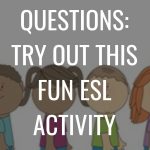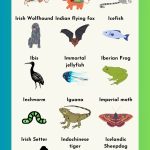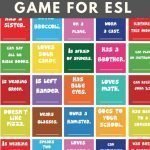Are you looking for some activities, games, worksheets and exercises to help your students practice some, any, much, many and other quantifiers? Then you’re in the right place! Keep on reading for our top recommendations for teaching ESL quantifiers.

Quantifier games and activities
Quantifiers Activities and Games for ESL
Let’s get to the best ESL quantifier activities and exercises.
#1: Find Someone Who Quantifier Bingo Game
I often use this Find Someone Who Bingo game as an icebreaker activity on the first day of class. However, it also works really well when talking about quantifiers. Here are some examples of the types of questions you could use. Find someone who . . .
- has a lot of pens in their suitcase
- doesn’t have any cash in their wallet
- doesn’t have much water in their water bottle
- has some snacks in their backpack
Find out more about how to this ESL quantifier game here: Find Someone Who ESL Bingo.
#2: Quantifier Go Fish Game
I’m sure you’ve played the card game Go Fish before. I LOVE to have my students play it with quantifiers. The way it works is that you can make some flashcards related to food, but it works best if you have singular and then plural versions of the same option. For example, a single banana and then a bunch of bananas. Or water and then a bottle of water.
Students can ask questions like the following:
- Do you have a banana?
- Do you have some bananas?
- Do you have some water?
- Do you have a bottle of water?
Then of course, the person responding can answer the question in the appropriate way. For example:
- No I don’t have one.
- Yes I have some.
- No I don’t have any.
- Yes, I have one.
- Amazon Kindle Edition
- Bolen, Jackie (Author)
- English (Publication Language)
- 87 Pages - 10/24/2019 (Publication Date)
Need more ideas? Check out: Singular and Plural Noun Activities.
#3: ESL Food Activities for Quantifiers
In ESL textbooks, quantifiers like some/any or much/many are often taught along with the unit on food. There are just so many possibilities, but uncountable/countable nouns is a frequently seen one. For example:
- I have some water
- I have a bottle of water
- Do you have any cookies?
- I have a few cookies.
- Etc.
If this is the case for you, then you might want to consider using some of these fun activities to spice things up a little bit. You can find all the details here: ESL Food Activities.
#4: Quantifier Videos
I’m ALL about using videos in my English classes. They’re engaging, fun and make the lessons more memorable. However, there’s way more to it than just hitting play and sitting back relaxing. To get the best use of videos in your TEFL classroom, consider using some pre and post-watching activities.
Do you want to see some of our top picks? Check them out here: How to Use Videos in the TEFL Classroom.
#5: Is that Sentence Correct
A simple review activity that’s ideal for teaching quantifiers is this one. The way it works is that you can make some sentences that have quantifiers in them, some of which are correct and other which are not. Then, students have to decide if it’s correct and if not, make the required changes.
Do you want to try it out with your students? More details here: ESL Sentence Correction Activity.
#6: Quantifier ESL Lesson Plan
It’s easier than you might think to make an ESL lesson about anything, including quantifiers. Find out how here:
#7: Dictogloss
This is a challenging listening-centred activity that can work well with quantifiers. Find (or write) a passage that has a lot of quantifiers in it. For example, perhaps someone is talking about the contents of their fridge or cleaning out their purse.
Put students into pairs and read it out at quite a fast pace for the level of students that you’re teaching. Then, each pair has to try to recreate the passage by either writing or speaking. Read it out again and students can improve upon what they have. Finally, they can compare it to the original version.
Do you want to find out more about it? You can learn more about one of the best quantifiers exercises here: ESL Dictogloss Activity.
#8: ESL Shopping Activities
The grammar point of quantifiers is often paired with the topic of shopping in many ESL textbooks. If you think about it, it makes a lot of sense. For example:
- Do you have any red shirts?
- It’s a little bit too small.
- There are lots of things that I like in this store.
If you want to try out some of these activities for shopping with your English learners, then you’ll want to check this out: ESL Shopping Activities.
- Amazon Kindle Edition
- Bolen, Jackie (Author)
- English (Publication Language)
- 85 Pages - 02/02/2020 (Publication Date)
#9: Listen for the Quantifiers
A basic principle when teaching English listening is that students need a reason to listen. In this case, you may want to have students try to find the quantifiers in a listening passage and write them down. Of course, choose your passage wisely and I find it really useful to tell students how many they should be able to find.
More details here: Listening for One Specific Thing.
#10: Proof-Reading and Editing
If students practice things only with speaking, it’s sometimes the case where they don’t really get the hang of all the small details and exceptions to the rules. In the case of quantifiers, there are certainly some tricky things to their use, especially with the negative and question forms.
One way to help students out with this is to make up a paragraph with some mistakes in it. In this case, you’d want to focus on quantifiers. Then, students have to work, either alone or with a partner to correct them. You can learn more about this ESL writing activity here:
#11: Yes/No ESL Activities
Quantifiers like some/any, many/much are often taught with yes or no questions. For example:
Do you have any milk? Yes, I have some/No I don’t have any.
Do you have an apple? Yes, I have one/No I don’t have one.
If you want to see some of our top recommendations for games and activities to help your students out with this style of English question, check out the following:
ESL Yes/No Question Activities.
#12: Flashcard Sentences
If you’re teaching quantifiers to beginners, then you may want to consider pulling out the flashcards. They’re one of the most under-utilized teaching tools in my opinion and you can really do so many things with them.
In this case though, you may want to show a student a card with a picture of something (or groups of things) on it and they have to make a grammatically correct sentence using a quantifier. For example:
- There’s a bottle of water.
- There’s some water.
- There’s a little water.
- Etc.
#13: Some/Any Vocabulary Auction
#14: How to Teach Grammar
Do you feel a bit lost when it comes to planning an ESL/EFL grammar lesson? Not to worry. Even many experienced teachers don’t really know where to start.
If this is the case for you, then consider checking this lesson planning template out: How to Plan an ESL Grammar Lesson.
#15: Picture Prompt
A nice way to introduce this grammar point to your students is to show them a picture with lots of stuff in it. For example, a messy bedroom. Then, elicit from the students what they see. For example clothes. Then, ask how many. A lot of clothes.
Or, you can show a picture like this at the end of the unit and get students to make some sentences related to what they see.
#16: Health Surveys
I love to use surveys in my English classes. They’re interactive, cover a wide range of skills and best of all, get students up and out of their seats talking to their classmates. In this case, make a variety of questions using how many or how much. For example:
- How much alcohol do you drink in a week?
- How many cigarettes do you smoke in a week?
- Etc.
If you want to know more about making your own surveys, then you’ll want to check this article out: ESL Surveys.
#17: Man/Woman on the Street Interview Activity
It can be kind of boring if we just tell students to ask their partner some questions using words like some/a few/much, etc. A better way to get students talking and using words like some/any/much/many is to do this creative interview activity.
Want to give it a try? You can find out all the details here: Man/Woman on the Street Interview.
#18: Closest in Meaning Quantifier Exercise
This is a simple reading activity that’s perfect for using quantifiers. Write one target sentence and then three other ones. One of the other ones should be very similar in meaning while the other two are less similar.
How you do this with words like any, many, a lot, etc. really depends on the level of the students but here is one example.
Target sentence:
I don’t have many apples.
Other sentences:
I have a lot of apples.
I have a few apples.
I don’t have any apples.
In this case, the second sentence is most similar in meaning to the target sentence. Learn more about this activity here:
Closest in Meaning ESL Activity.
#19: Mixed Up Sentences
If you want to focus on forms for sentences that use these kinds of words, try out this simple activity, mixed up sentences. Write some sentences using quantifiers, but then mix up the word order. Students have to work together in pairs to unscramble the sentences. It also makes a nice homework assignment.
#20: Concentration
This is a fun game that helps students with the meaning of these kinds of words. Make up some matching cards. One card should include a simple picture and then another card, a sentence describing it. For example:
- A picture of 3 apples
- I have a few apples.
Then, cut them out and students have to play a matching memory game in small groups. Find out more about how to set it up here:
#21: Error Correction Relay Race
I like to use this game to take something old (error correction) and make it new again. Students have to work together to correct a worksheet with errors. Most of them can focus on form, but throw in a few that deal with meaning too to make it interesting.
Find out more about it:
#22: Dialogue Substitution
#23: Shopping Spree
Create a shopping scenario where students pretend to be customers. Provide them with a list of items to buy, along with specific quantifiers (e.g., a carton of milk, a bunch of bananas, a jar of peanut butter). Students can work in pairs or small groups to discuss and decide how many items they need to buy based on the given quantifiers.
#24: Picture Sorting
Prepare a collection of images or flashcards representing different objects, animals, or people. Divide the class into groups and give each group a set of quantifier cards (e.g., some, many, few, several). Students must categorize the pictures according to the appropriate quantifier and explain their reasoning.
#25: Scavenger Hunt
Hide various objects or pictures around the classroom or outdoor area. Provide students with quantifier prompts, such as “Find a few pencils” or “Locate several books.” Students work individually or in pairs to search for the items and report back using the correct quantifiers.
#26: Shopping Game
Create a shopping list with different items and their quantities. Divide the class into pairs or small groups and give each group a set of play money. One student acts as a shopkeeper, and the others are customers. The customers take turns asking for items from the shopping list using quantifiers. For example, “Can I have three oranges, please?” The shopkeeper responds, “Sure, that will be $3.” This activity reinforces the use of quantifiers in a practical context.
#27: Quantifier Sort
Prepare a set of sentence cards, each containing a sentence with a quantifier (e.g., many, few, a lot of, some, any, etc.). Have students work in pairs or small groups. They should sort the cards into two categories: “Positive Quantifiers” and “Negative Quantifiers.” After sorting, they can discuss the reasons for their categorization and practice using the quantifiers in sentences.
#28: Board Game
Design a board game with different spaces that represent situations where quantifiers are used. Students roll the dice and move their game pieces accordingly. When they land on a space, they must use a quantifier to describe the situation. For example, if they land on a space with a picture of a party, they might say, “There are a lot of people at the party.” This game allows students to practice using quantifiers in context while having fun.
List of Common English Quantifiers
There are a few different types of quantifiers in English that you should be aware of. Here are some of the most common ones to be aware of:
- some
- any
- (too) much
- (too ) many
- a lot of
- lots of
- a few
- a little
- several
- enough
- most

English Quantifiers
Quantifiers Worksheets
If you’re looking for some quantifiers exercises, then you’re definitely in the right place! Here are some of the best resources to find quantifier worksheets, along with answers to make your life easier:
Some Any Worksheets
If you’re teaching the differences between some and any, here are a few worksheet recommendations:
ESL Lesson Plans for Quantifiers
Are you looking for some ESL lesson plans that you can use for quantifiers that you can just print off and take to class with you? What busy teacher isn’t, right? Check out our top recommendations to help save you a ton of time:
Quantifiers Online Exercises
If your students want some extra practice with these kinds of words, here are some exercises that they can do online:

Quantifiers exercises
English Quantifiers FAQs
There are a number of common questions that people have about English quantifiers. Here are the answers to some of the most popular ones.
What is a quantifier with example?
A quantifier is a word that goes before a noun and expression how much or how little of something there is. For example, “A little milk.” Or, “There are many apples.”
How do you teach quantifiers for beginners?
The trickiest part of teaching quantifiers for beginners is demonstrating the difference between countable and uncountable nouns because this will impact which quantifier is used. Use plenty of concept checking questions and provide opportunities for practice with this.
Why are quantifiers important in English?
Quantifiers are essential for understanding and expressing the amount or degree of things, making communication more precise.
How can I introduce quantifiers to ESL learners?
Start by teaching basic quantifiers like “some,” “any,” “few,” and “many” and gradually introduce more complex ones.
What’s the difference between “some” and “any”?
“Some” is used in positive sentences, while “any” is used in negative sentences or questions. For example, “I have some apples” and “Do you have any apples?”
How can I practice quantifiers with ESL students?
Use exercises and activities that involve counting, such as counting objects, filling in the blanks with appropriate quantifiers, and discussing quantities in real-life scenarios.
What are uncountable nouns, and how do quantifiers relate to them?
Uncountable nouns refer to things that cannot be counted individually, like “water” or “furniture.” Quantifiers help express the quantity of uncountable nouns, such as “a glass of water” or “a piece of furniture.”
What are the challenges ESL learners face with quantifiers?
ESL learners may struggle with choosing the right quantifier, especially when dealing with countable and uncountable nouns. They might also have difficulty with nuances like “a little” vs. “a few.”
How can I assess students’ understanding of quantifiers?
Use quizzes, worksheets, and oral exercises that require students to use quantifiers in context, such as describing pictures or explaining everyday situations.
Did you Like these ESL Quantifier Activities and Games?
- Amazon Kindle Edition
- Bolen, Jackie (Author)
- English (Publication Language)
- 87 Pages - 10/24/2019 (Publication Date)
Yes? Thought so! Then the book you’re going to love is this one over on Amazon: 39 No-Prep/Low-Prep ESL Grammar Activities. If you teach English grammar, the key to interesting and engaging classes is a wide variety of games and activities. This book will help you get through the entire semester in style, whether you teach beginners, intermediates or adults.
You can easily get the book in both digital and print formats. The digital copy can be read on any device, including your PC, phone or tablet by downloading the free Kindle reading app. Take it with you to your favourite coffee shop for some serious lesson planning on the go. Or, consider keeping a copy on the bookshelf in your office to use as a handy reference guide.
It really is that easy to have better English classes! So, head on over to Amazon to pick yourself up a serious dose of ESL teaching awesome:
Tips for Teaching English Quantifiers
Teaching quantifiers to ESL learners can be made more effective with the following tips.
Clear Explanations
Start by providing clear explanations of what quantifiers are and how they are used in English. Use simple language and provide plenty of examples to help students grasp the concept.
Contextualize Usage
Show students how quantifiers are used in real-life contexts. Provide examples and scenarios where quantifiers are commonly used, such as shopping, describing people and things, talking about habits, etc. This helps students understand the practical application of quantifiers.
Use Visual Aids
Incorporate visual aids such as pictures, flashcards, or graphs to illustrate the concept of quantifiers. Visual representations can enhance students’ understanding and make the learning process more engaging.
Do Some Practice Activities
Design a variety of activities that allow students to practice using quantifiers. These can include role-plays, surveys, games, and worksheets. Provide ample opportunities for students to actively use quantifiers in speaking and writing tasks.
Error Correction
Pay attention to students’ usage of quantifiers and provide timely error correction. Encourage students to self-correct by asking follow-up questions. For example, if a student says, “I have much apples,” you can ask, “Is ‘much’ the correct quantifier for countable nouns like apples?”
Quantifier Drill Exercises
Use drill exercises to reinforce the correct usage of quantifiers. Provide sentences with gaps, and students fill in the appropriate quantifier. This can be done orally or through written exercises. Some more ideas here:
Group Discussions Using Quantifiers
Encourage group discussions or pair work where students have to express their opinions or share information using quantifiers. This helps develop their fluency and accuracy in using quantifiers in a conversational setting.
Regular Review
Schedule regular review sessions to revisit the concept of quantifiers. Recap previously taught quantifiers and provide additional practice to solidify students’ understanding.
Real-life Examples
Bring in real-life examples from newspapers, magazines, or online articles that contain quantifiers. Discuss and analyze the usage of quantifiers in those contexts to expose students to authentic language use.
Individual Feedback
Provide individualized feedback to students on their use of quantifiers. Offer specific suggestions for improvement and highlight areas where they are using quantifiers correctly.
Have Your Say about Quantifiers Exercises and Activities
What are your thoughts about these TEFL games and activities to work on quantifiers like some, any, much and many? Did you try out one of them from this list, or do you have another activity that you’d like to recommend? Leave a comment below and let us know what you think. We’d love to hear from you.
Also be sure to give this article a share on Facebook, Pinterest, or Twitter. It’ll help other busy English teachers, like yourself find this useful teaching resource.
Last update on 2022-07-17 / Affiliate links / Images from Amazon Product Advertising API






